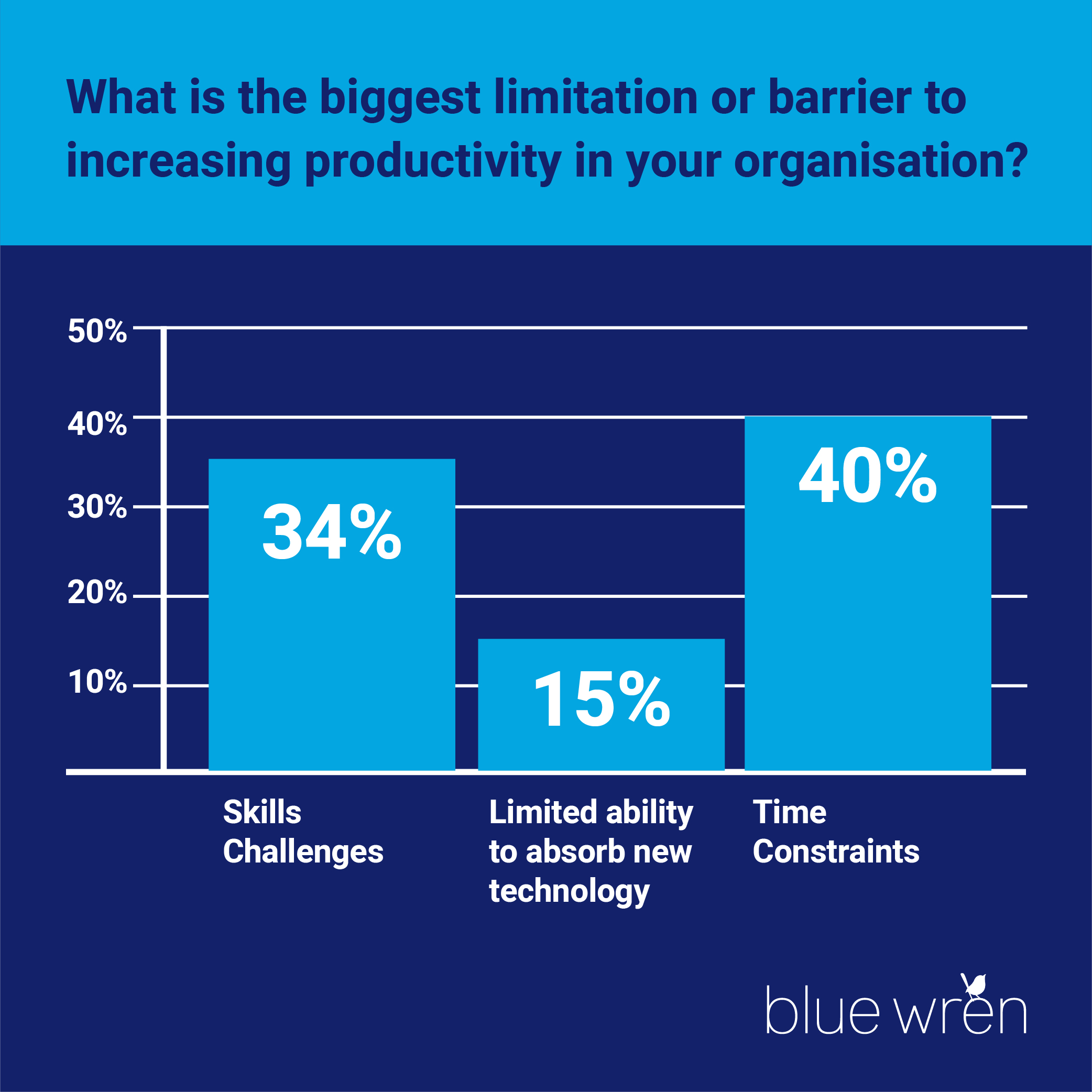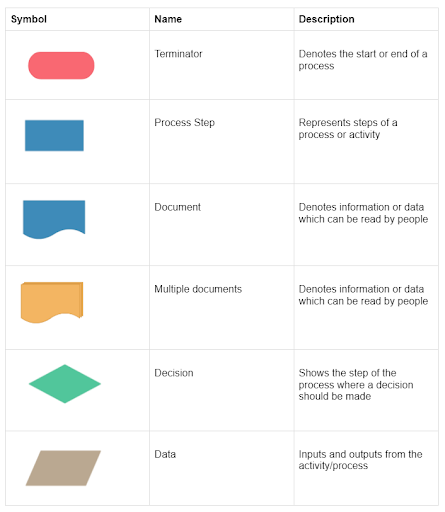Process mapping. While this term might sound a bit vague or waffly, process maps are surprisingly straightforward to create, and a good way to share concise information in a universally recognized format.
It can also help you revise your procedures, use your process map to train recruits, and show them to potential investors to demonstrate that you’re a serious business with carefully organized methods.
And with 40% of folks feeling that “time constraints” are the main barrier to increased productivity, process mapping can help with making processes more efficient and increasing productivity.

What is a process map?
A process map is a way to visually lay out the different steps of an activity or project, along with each person responsible for the different steps in the process/activity. A flow chart is one example of a process map, where every step is coded with different shapes, and connected with arrows.
When are they used?
Process maps can be used at multiple points within your work, and are typically used for the following:
- Documenting and modeling a process/activity/material
- Finding solutions to problems, like weaknesses in a BYOD policy
- As a communication tool within and between teams
- To lay out and plan new projects
- To plan, manage and analyze work processes
- For identifying inefficiencies within (and between) processes and activities
- To better understand decision-making processes
- To decide which future projects to focus on
- To organize your email marketing strategies
What are the benefits of Process Mapping?

Some of the benefits of process mapping include:
- The ability to simplify complex ideas by breaking them down into smaller parts, which is useful for staff, managers, and stakeholders alike
- Process documentation for old and new employees to use on a daily basis
- It can be used as a tool when it comes to training new employees
- It offers clarity of communication through the visual, user-friendly layout
- It can be used to notice ineffective or illogical work processes, such as duplications or gaps in the work, and to implement any necessary changes
- Helping staff to improve their performance, simplify their tasks and increase work satisfaction rates
- Faster decision-making processes are boosted thanks partly to better communication
- Simplified responsibility delegation, as well as being able to see who is responsible for what
- Improved understanding of how processes work, which enhances the automated parts of your workflow, be it automated HR, marketing, or any other department
- Self-service guidance for staff, which reduces pressure on the team
- Useful for scenario testing brainstorms
- Process maps are often a requirement for different standards and certification types
- They are something to show investors to prove that your company is reliable
- By increasing efficiency, process mapping helps to reduce the costs and the amount of time spent on various work activities
As you can see, there are quite a few different but interrelated benefits to mapping your processes.
The steps
So how do you go about creating a process map?
1: Decide which process (or problem) you want to map out
If there’s something that is currently residing solely in the brain of your most experienced project manager, it’s perhaps time to put that process on paper - map it out. Do you want to make it easier for new recruits to learn your processes? Is something taking longer than it should in the office and you want to automate? Maybe you need to create a process map to meet an industry standard.
Whatever the reason for making a map, the first step is to clearly identify exactly what you want to untangle, whether it’s a process or a problem.
2: Make a list

The second thing you need to do is list every single step of the process. You can write it as a brain dump on a page and rearrange it as you go. You could write each step on a post-it note or magnet and then move those around as required. Sometimes old(er) school is best, though you could just use a collaborative software tool to do this part electronically and cooperatively with your team.
Make sure that whichever method you choose, you involve any relevant team members and stakeholders, and that for each step of the process, you include the individual or individuals responsible for that stage.
3: Find your start and endpoints
Once you have listed all of the steps, make sure that you have clarified your start and finish points. It can be easy to let a process go on and on, merging with other, related processes. However, you need to keep individual processes clear and easy to follow, so just keep that in mind when deciding where to end the process.
Just as important is deciding where your process begins. It can be tempting to keep tracing a process further and further back. One way to decide where your process begins is by identifying a trigger. When X happens, that initiates process Y. This way you can identify the first logical course of action or step in that particular situation.
4: Flesh out the details
You need to have enough detail in your process map for it to be complete in and of itself. If you could give your map to a new recruit and they understand it, you’re on the right track. A fresh set of eyes can help you to determine whether it makes sense or not. If you’ve been in an organization a long time and you’re mapping an old process, it can be very easy to fall into the trap of omitting essential details.
5: Order your steps

At this point, you should get your ducks in a row. Finalize the order of the steps, and get everyone involved to check that they’re happy with it. This will help you in identifying any gaps or missing information.
6: Chart it up
Now that you know what your steps are and which order they go in, it’s time to assign symbols to each part, add in the arrows to show the flow direction, and choose the appropriate map type.
7: Make any finishing touches
At this stage, you want to review the map again with everyone involved and make sure that everyone is happy with how it looks.
8: Look for areas of improvement
Now that you have your map (yay! Well done! We know it’s time-consuming), you can clearly look at each step and decide whether, or how, to change up your process to make it more efficient. If you just wanted to map your process to make it easier for others to follow the steps, then you might not need this step.
But if you wanted to do this in order to improve your processes, then you will now have a great visual tool that you can edit and play around with.
What you’ll need
The symbols

Image Created by Writer
These are some of the most commonly used symbols for process mapping, but they’re far from exhaustive. There are plenty of others you can use for more specific work processes.
The symbols are also connected by arrows to show the flow direction of the processes and activities.
Map types
Flow-chart: also known as the classic, this is the simplest kind of process map with clear inputs and outputs. It’s the vanilla scoop of ice cream flavors.
The high-level process map: a top-down map that shows the essential elements of the process without any fluff. The frozen water version of ice cream “flavors”.
SIPOC map: it stands for Suppliers, Inputs, Process, Outputs, and Customers. This is more of a chart than a process map and includes key information that can later be used in the creation of a more detailed process map. This is the lazy susan, with all ice cream flavors and sprinkle options on display.
Value stream map: value stream mapping essentially focuses on how a service is delivered to the client. This is the Magnum of ice creams - straightforward and practical.
Deployment flowchart: aka the swimlane. It illustrates the connection between the steps in the process and the teams responsible for completing them using "swim lanes". This is the multipack of mini ice creams that you share out with your friends at the park.
Detailed process map: The opposite of the high-level process map, this one is hyper-detailed at each step and also includes subprocesses. This is the most thorough process map and is very useful for revealing weak areas in the process. Behold, the banana split sundae of process maps.
Process mapping is a key component of workflow productivity
Process mapping creates clarity which creates the room to make useful changes and communicate more effectively with your team. The time it takes to make a map is definitely worth it because, in the long run, it’ll save you a lot of time with training new hires, involving teammates on projects, and streamlining your work. It also looks and feels professional.
About the author:
Grace Lau is the Director of Growth Content at Dialpad, an AI-powered cloud PBX system and cloud communication platform for better and easier team collaboration. She has over 10 years of experience in content writing and strategy. Currently, she is responsible for leading branded and editorial content strategies, partnering with SEO and Ops teams to build and nurture content. Here is her LinkedIn.
What would you like to know and what would be the best way to share this information with you? What are the best tips & tricks, what workaround do you use? We'd really appreciate your insight on these ones to make our integrations better, more productive, and much more efficient. Comments, tweets are always welcome.